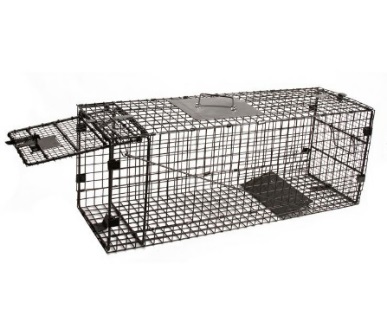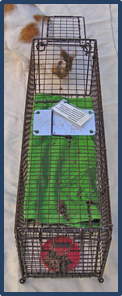Trapping & Trap Rentals
How do I Get a Trap?

Nevada Humane Society offers high-quality TruCatch traps that can be loaned out to members of the community. We ask for a pay-if-you-can $10 rental fee for the use of each trap and a replacement value deposit that will not be charged or collected unless a trap needs to be replaced. If you have financial limitations, we're more than happy to work with you! This fee, however, allows us to continue offering trap rentals to the public..
UPDATE 4/20/2022: Costs of traps have gone up. Below are prices and links to the traps in question. Please remember that the deposit will not be charged/collected unless a trap needs to be replaced!
* TruCatch LTD Trap (Standard): $89.99 [link]
* TruCatch Fat Cat Trap: $110.99 [link]
* Tomahawk Drop Trap: $125.00 [link]
In general, we prefer that you reach out to our Community Cat Program through email (communitycats@nevadahumanesociety.org) or phone (775-856-2000 ext. 337) to inquire about traps. We rent out traps as available. We’ll discuss with you what you need the trap for and how to best go about utilizing it. After you’ve been approved by a member of staff, you can come down to the adoption center any day from 11am-2pm and 3pm-6:30pm, excluding major holidays/weather-related closures.
How do I Set a Trap?
Nevada Humane Society utilizes TruCatch box traps for our feral cats. Click here for an instructional video on how to best set the trap. [NOTE: this video is from a different organization, so some of their information is not accurate to Nevada Humane Society’s clinic.]
Click here for an instructional video on how to set up a Tomahawk Drop Trap for targetted trapping and/or to catch multiple cats at once.
If you don't have a drop trap but do need to trap a specific cat out of a group, please watch this video. A written guide can also be found here for kitten-napping.
Got a mom with kittens who's not taking the bait?
Community Cats Podcast hosts free educational webinars on trapping that are extremely helpful.
How do I Prepare for Trapping?
FEEDING
Even if a trap is not available, the first and most important step is getting the cats on a strict feeding schedule. Cats are creatures of routine and habit, and it is important to:
1. be able to expect a cat at a specific time and place
2. be able to manipulate their food source
Cats should be fed once or twice daily, ideally in the early morning or late evening (near sunrise and sunset). There should only be enough food for the cats to eat within 30 or 60 minutes, though cats typically only need 1/3-1/2 cups of dry food per day (more in the winter).
If the cats seem to be arguing over food, this is normal! They’ll figure it out, and getting the cats neutered will help with any territorial aggression. It's okay to have multiple feeding stations, and sometimes this actually makes it easier to trap.
Do not leave out excess food, as this WILL attract insects, pests, and additional cats that are likely being fed by others in the neighborhood. Feeding at low-traffic hours will also help the cats to stay out of sight of the general population, which will in turn help prevent them from being a nuisance.
ACCLIMATING TO THE TRAPS
Since our TNR clinic is by appointment, we want to remove as many variables as possible prior to trapping in order to set it up for success. Ideally, there would be at least one week spent building a positive association with the traps to make them seem less scary and more like a normal part of their eating routine. They need to be fed EXCLUSIVELY out of the traps during this period.
1. Once a trap is acquired, the cats should be fed with the trap sitting close to their normal feeding station.
2. Wire/zip-tie both doors open and start putting food in the middle.
3. As they get more comfortable, close the back door and feed them just inside the open door.
4. Slowly move food farther and farther inside the trap each day, first without and then with a cover.
You’ll essentially be getting them used to the traps as open as they need to be, and slowly morphing them into what they’ll look like on the night of trapping.
* Some cats will be harder than others to convince that the trap is safe. It may take longer, and you may have to take more steps in getting them used to the way the trap will look when it is actually set.
* Taking out the trap bottom and rubbing it on the ground may help it smell more familiar ("like home") and therefore less scary.
* Traps should ideally be set/braced up against something (the house, a deck, items in the yard, under vehicles) and in the cats' normal path as opposed to open spaces. Make sure it doesn't wobble easily.
* If it’s windy, add a heavier cover (towel, blanket) or something to hold down the cover. Clothespins work great!
* Make sure the cover isn't too tight as to obstruct the door. There should be nothing for the door to catch on; if it doesn't shut all the way, cats will have the opportunity to force their way out.
How Do I Start Trapping?
1. When ready to start, do not do the regular feeding. Some hunger will make the bait more attractive.
2. Place the bait at the end furthest from the trap entry, beyond the release plate. Be sure that the food will not interfere with the release plate. Make a small trail of TINY food morsels leading from the set open door of the trap to the closed end (where bait is).
3. Set the trap. Covering all but the door opening to the trap gives the illusion of a secure hiding spot. Make sure that the cover will not obstruct the door closing.
4. Wait. Do not leave visual range, but watch at a distance. Try sitting in a nearby car.
5. As soon as the cat is trapped, make sure the entire trap is covered. Place the cat in a quiet, safe place until transporting to the clinic. DO NOT attempt to adjust/move anything inside of, into, or out of the trap while the cat is inside.
6. Keep a record of the cats that you trap. If it is possible to take a photo of each cat, this is ideal. After surgery, record the description, sex, approximate age, dates and locations of trapping.
It is very important that the trap never be left unattended. Traps can be stolen or damaged, and cats in unattended traps can:
* Injure themselves trying to escape
* Be attacked, injured, or traumatized by dogs, raccoons, and other animals
* Be released, making it much more difficult to re-trap the now trap-shy cat
What to Do If the Cat Won't Go In the Trap
Vary the way that you cover the trap. Some cats will only go in if they can see out the far end. Others prefer the trap to be completely uncovered; make sure you fully cover the trap as soon as they are trapped!
Make them wait. First, wait 2 hours past the regular feeding time. For a particularly trap-savvy cat, you might consider offering less food for a few days. Water should always be provided.
Make the traps more enticing. Try different bait; sardines, deli turkey, canned meat baby food (without onion!), and cooked chicken are favorites. Some trappers swear by KFC drumsticks hung at the back. Catnip and valerian root powder may also work. NHS staff and volunteers generally use the stinkiest, most "organic" or unprocessed foods we have available from our donations. The smellier the better.
If the cats have a cold, they may not be able to smell the food very well. This might be a good opportunity to use a drop trap, or to leave the trap uncovered and watch it VERY CAREFULLY so that you can cover it the moment a cat gets caught. Try dangling a shiny piece of ribbon or other interesting cat toy to get their attention. This may bring them close enough to visually notice the food instead of reling on their ability to smell it.
Try using a larger trap. Some cats, particularly larger cats, may be reluctant to go into the regular-sized traps. NHS does have some "fat cat" traps that can be rented out.
Take a break from trapping. If a cat will not go into a trap after repeated attempts, take a break for a week or two (except in the case of an injured cat). The trap-shy cat needs to be reconditioned to not be afraid to go in. Continuing will most likely result in the cat becoming increasingly reluctant.
Use distraction techniques to help coax the cat onto the trigger plate. You may be able to guide some cats into a trap with a laser pointer from a distance.
Place the trap in a more secluded location or camouflage the trap. Moving the trap to a quieter or more protected location can raise the cat’s comfort level enough to enter. Or, you can try to blend the trap in with its surroundings. First, hide the trap under a bush, under a leaning piece of wood, or in a box so the cat feels like he is entering a dark hole. To further disguise the trap, cover it with branches, leaves, camouflage material, burlap or other natural materials. Even simply covering the trap with dark cloth or a towel can do the trick. Be sure that the coverings you use do not interfere with the trap door closing.
How Do I Release the Cats?
Cat should be kept warm for 12 hours after their surgery because they cannot control their body temperature. Cats can be released the following morning where they were trapped—gently and away from traffic. Feral cats experience extreme stress while in captivity, and they should not be held longer than necessary.
Mass/"Whole Colony" Trapping
The most effective way to trap is to capture all of the cats at once, or in a two-three day period. This can be a bit complicated, but if someone (sometimes with the help of neighbors) is able to set, monitor, and transport the traps, NHS is happy to help make it happen.
Instead of taking years plucking away at a colony, we can fairly easy trap 25 cats (the full number of TNR surgeries we can currently offer).
This is what a typical mass-trapping schedule might look like:

On the shelter side, the set-up, record-keeping, and maintenance of the cats and their housing is quite labor and time intensive, so it is important that as many roles (trapper/transporter) are filled by residents/caretakers as possible.
Particularly as trapping efforts pick up in the Spring and Summer, mass trapping events will likely need to be scheduled at least a month in advance.
